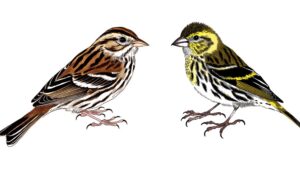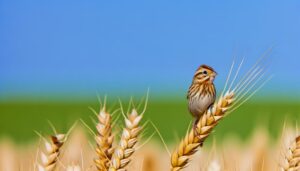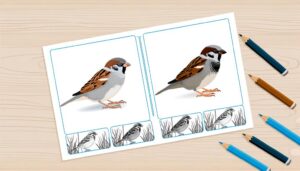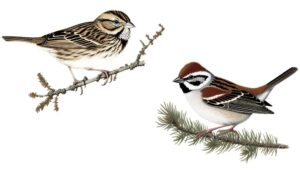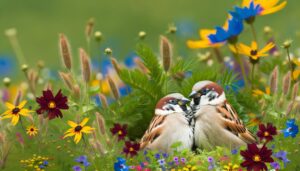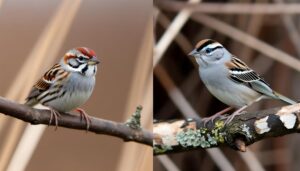How Does the Introduction of Chipping Sparrows Impact the Environment?
The introduction of a Chipping Sparrow notably impacts the recipient environment. This bird increases competition for food and nesting sites, often distressing other avian species.
It notably alters plant and insect populations, affecting local biodiversity. While the sparrow can cause imbalances, it also aids in seed dispersion, aerates soil, and naturally controls certain pests.
Overpopulation, however, may lead to dominance, disrupting ecosystem dynamics. Further exploration offers insight into mechanisms for mitigating potential negative effects, maintaining ecosystem balance, and understanding the Chipping Sparrow's role in diverse habitats.
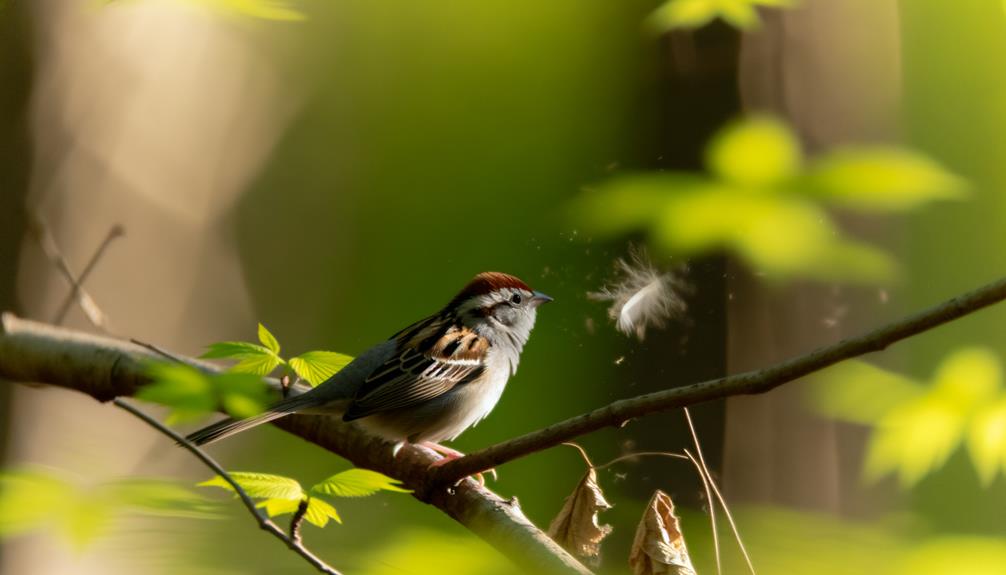
Key Takeaways
- The introduction of a Chipping Sparrow can lead to increased competition for food and nesting sites among other bird species.
- It can cause distress and disrupt communication and mating rituals in existing avian communities.
- Chipping Sparrows contribute to seed dispersal and new plant establishment, enhancing local plant biodiversity.
- Their predation habits can reshape insect populations and dynamics within the ecosystem.
- However, an overpopulation can cause imbalances in plant and insect species, altering the overall health of the ecosystem.
Understanding the Chipping Sparrow
The Chipping Sparrow, a small and common songbird, captivates ornithologists with its distinct chipping sounds, slender beak, and striking rust-colored cap. Scientifically classified as Spizella passerina, it's part of the Passerellidae family, often called New World sparrows. It's known for its delicate size, typically weighing between 11-16 grams and spanning about 12-14 centimeters in length.
The bird's overall color varies from a dull, earthy brown to a more vibrant gray, with a unique rust-colored cap and a black, sharp-edged white stripe running across its eyes, distinguishing it from others. It's the bird's song, a rapid, mechanical trill, which truly sets it apart. This acoustic signature, used for staking territory and attracting mates, provides a fascinating study for scientists and bird enthusiasts alike.
Chipping Sparrow's Natural Habitat
The Chipping Sparrow exhibits a wide geographical distribution, thriving in various regions across North America. Its habitat preferences, however, reveal a predilection for open woodlands, gardens, and parklands, where it finds ample resources for survival.
Through a scientific and analytical lens, understanding the sparrow's habitat choices provides key insights into its behaviors, survival strategies, and adaptability to environmental variations.
Sparrow's Geographical Distribution
Spanning a vast range, Chipping Sparrows inhabit various regions across North America, venturing into the central regions of Mexico during winter migrations. Their geographical distribution extends from the Atlantic to the Pacific, excluding the Arctic tundra and the desert southwest.
This species is also found in parts of Alaska and Canada in the warmer months, indicating a preference for temperate climates. Interestingly, Chipping Sparrows demonstrate considerable adaptability, occupying both rural and urban environments. In urban areas, they're often sighted in parks and gardens.
It's important to note that although they have a wide geographical distribution, their population density varies considerably across different regions. This variability in distribution is likely influenced by multiple factors that will be explored further.
Habitat Preferences
Digging into their habitat preferences, Chipping Sparrows frequently nest in open woodlands and forest edges, showing a marked preference for areas with sparse undergrowth and ample ground cover. They favor habitats with a mix of grasses and herbs for foraging, with a concentration on seeds and insects.
This preference aligns with their nesting habits, as they often construct nests low to the ground, typically in shrubs or low tree branches. These specific habitat preferences suggest an adaptation to environments that provide both food and shelter resources, while also minimizing exposure to predators.
Chipping Sparrows' habitat selection consequently appears to be a critical aspect of their survival strategy, highlighting the importance of preserving these specific ecosystems.
Impact on Local Bird Populations
Chipping Sparrows, with their rapid proliferation, have elicited noticeable shifts in local bird populations. Their aggressive feeding habits and territorial behavior have upset the ecological balance, causing distress among other avian species.
Studies reveal increased competition for food and nesting sites, leading to the displacement of certain birds. Their invasive nature impacts the breeding success of other species, causing population declines in some. Their call, a long, trilled song, interferes with the communication of other birds, disrupting their mating rituals.
Despite their small size, Chipping Sparrows manage to outcompete larger birds for resources, demonstrating their adaptability and resilience. Understanding these effects is essential for devising effective conservation strategies to ameliorate the disrupted avian ecosystems.
Effects on Plant Life
Chipping Sparrows not only affect other avian species but also play a role in influencing plant life in their habitats. Chipping Sparrows, primarily seed eaters, help in the spread of plant species. They consume a variety of seeds and, through their droppings, disperse them over a wide area. This seed dispersal allows for the establishment of new plant populations, enhancing biodiversity.
Additionally, their foraging habits can also impact plant growth patterns. They often forage on the ground, scratching and pecking at the soil. This behavior aerates the soil, encouraging plant growth. However, it's important to mention that an overpopulation of these sparrows can lead to an imbalance, potentially causing a decrease in certain plant species and altering the ecosystem's overall health.
Changes in Insect Populations
Insect populations, too, experience significant shifts due to the dietary habits of the Chipping Sparrow. As insectivorous birds, Chipping Sparrows primarily consume insects, particularly during their breeding season. Consequently, insect communities within their habitats undergo considerable changes.
Key insects in their diet, such as beetles, caterpillars, and aphids, see a decline in numbers. This targeted predation can imbue a selective pressure on these insect populations, potentially leading to evolutionary adaptations over time. Additionally, such declines can create a ripple effect, impacting other insect species not directly preyed upon by sparrows.
For instance, a reduction in aphid populations might reduce food availability for ladybugs, subtly shifting the dynamics within the insect community. This way, the introduction of Chipping Sparrows can reshape insect populations.
Influence on the Ecosystem Balance
As a key component of its ecosystem, the Chipping Sparrow's dietary habits greatly shape the balance of insect populations. Acting as a natural predator and controlling agent, the bird's feeding patterns indirectly affect the health of plant life.
Hence, understanding the Sparrow's role is essential in evaluating and predicting ecosystem dynamics.
Chipping Sparrow's Dietary Impact
Feeding mainly on insects and seeds, the Chipping Sparrow plays a crucial role in maintaining the balance of its ecosystem. Its dietary habits have a direct impact on local insect populations, controlling their numbers and preventing overpopulation. Similarly, by consuming seeds, they assist in plant propagation, scattering seeds in their droppings, thereby encouraging plant diversity.
To illustrate, consider the following table:
| Food Source | Ecosystem Impact |
|---|---|
| Insects | Controls population, prevents overpopulation |
| Seeds | Assists in plant propagation, encourages diversity |
However, the introduction of the Chipping Sparrow into new ecosystems can have unforeseen effects. It is vital to monitor these changes to ensure the balance of the ecosystem remains undisturbed, highlighting the importance of understanding the sparrow's dietary impact in its environment.
Predation Role in Ecosystem
Besides its dietary impact, the Chipping Sparrow's role as a predator greatly influences the balance within its ecosystem. By consuming a variety of insects, this bird helps control pest population, thereby curbing their potential to damage the ecosystem.
However, the Chipping Sparrow's predation also affects the food chain. By being a dominant predator, it can influence the populations of its prey, potentially leading to a decrease in numbers. This, in turn, might disrupt the food availability for other predators that share the same prey.
It's pivotal to study the Chipping Sparrow's predation habits to predict and manage its impacts. Consequently, maintaining an ecosystem's balance involves understanding and managing the complex interplay of predator-prey relationships such as that of the Chipping Sparrow.
Effects on Plant Life
While the Chipping Sparrow's predation role is essential, its interaction with plant life greatly contributes to the ecosystem's balance as well. These birds scatter seeds as they feed, unintentionally promoting plant diversity and growth. Their droppings also fertilize the soil, enriching it with nutrients important for plant health.
Interaction doesn't stop at the ground level. In their nesting habits, Chipping Sparrows choose branches of shrubs and trees, indirectly aiding in their growth by deterring pests. Additionally, the materials they gather for nest-building, such as leaves and twigs, can stimulate new growth in the plants they're sourced from.
Therefore, through their feeding, nesting, and waste, the Chipping Sparrow's presence in an ecosystem has a significant, beneficial impact on plant life and overall ecological balance.
Mitigating Potential Harmful Effects
To mitigate potential harmful effects on the Chipping Sparrow population, it's important to implement strategic conservation measures. These measures should focus on habitat preservation, climate change adaptation, and minimization of human interference.
Habitat preservation involves protecting and restoring areas where these birds naturally thrive. This ensures the availability of food, nesting materials, and shelter for the Chipping Sparrows.
Adapting to climate change requires studying how changing weather patterns affect the species and adjusting conservation strategies accordingly.
It's also essential to minimize human interference, as urbanization, pesticide use, and outdoor pets can be detrimental to these sparrows.
These mitigation strategies, in conjunction with regular monitoring of the sparrow population, will help maintain a healthy, flourishing community of Chipping Sparrows.
Conclusion
In nature's grand tapestry, introducing a Chipping Sparrow is akin to adding a new color thread. It may seem insignificant, yet it subtly alters the whole picture.
It affects bird populations, flora, insect communities, and ecosystem balance. As stewards of this tapestry, we must continue to analyze these shifts, mitigating potential harm while appreciating the intricate beauty it imparts.
The chipping sparrow's story is a reminder that every thread, every species, plays a pivotal role in our ecological masterpiece.

